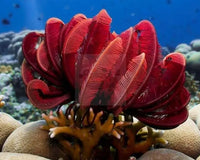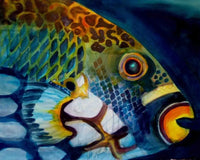Marine fish come in the most wonderful colorations, compared to Freshwater fish. It is not hard to see why they are the number 1 choice for aquarium hobbyists and displayed in some of the most beautiful saltwater aquariums around the world. With up to 15,000 known species it can be hard to choose a favorite; here we have a diverse list of some of our personal favorites marine fish.
Copperband Butterfly (Chelmon rostratus)
The Copperband Butterflyfish can be found across Indonesia and Australia. This beautiful butterflyfish has a long narrow nose and orange vertical stripes with a large black circle on the dorsal. This butterfly can reach up to 8” in size and is known to have a peaceful temperament. They enjoy grazing on the rocks, using their pointed nose to reach into tiny holes and hard to reach areas. Be warned, like most butterflyfish, Copperbands may nibble at inverts and corals.
Blue spot Jawfish (Opistognathus rosenblatti)
This beautiful Jawfish is native to the Gulf of California, they inhabit slightly cooler waters than most popular marine fish. These fish are mostly yellow/orange which gets darker down the length of the fish's body. Bright blue spots run the length of the body, these are often fluorescent in colour. Blue Spot Jawfish like most Jawfish create a burrow in the sand, in which they will sit with their head slightly exposed, they will open their mouths wide as a threat to any fish passing by and waiting for food to pass. They can be a fun fish to observe with their comical mouth warning (which is common of jawfish) and their excessive need to have a tidy burrow, often moving things around and re-arranging the surrounding sand.
Yellow Tang (Zebrasoma flavescens)
The Yellow tang or Hawaiian Yellow surgeonfish is native to the Hawaii Islands. These are classed as medium sized tangs, reaching 10” when fully mature. What makes these tangs so striking is their bright yellow colour. This is one of the more easier marine species to keep due to their diet and so is must have for any saltwater aquarium.
Coral Beauty (Centropyge bispinosa)
The Coral Beauty is also known as the Two-spined Angelfish or Dusky Angelfish. This Angel can vary in colour, often due to the location or depth that the specimen was collected. They typically display an orange belly, with deep purple or blue edges and stripes. Being a dwarf Angelfish, this species stays small at 3”. They are suitable for beginners and are highly compatible with most other reef fish.
Carpenter's Flasher Wrasse (Paracheilinus carpenteri)
This Wrasse is one of the most popular Wrasse species in the marine aquarium trade; they are generally reef safe and will not bother inverts. This stunning Flasher Wrasse is deep orange in colour; the belly is white in colour with purple and blue lines throughout the body. The males of this species have a high dorsal and are more vibrant in colour, they will display to the females by “flaring” their fins.
Queen Angel (Holacanthus ciliaris)
The Queen Angelfish is a stunning fish; these exquisite angelfish can be found off the coast of Florida, Brazil, the Bahamas and off the Gulf of Mexico. The queen angel is blue with yellow scales and a bright yellow tail, they display a black circle on the forehead edges with blue. These Angels can live up to 15 years old and reach 17” in length. As juveniles the Queen Angelfish look quite different, they have a blue body with brighter blue vertical stripes, this act as a camouflage in the reef. Due to their large size and aggressive nature, these fish are recommended for the experienced marine fish keeper only.
Wreck Fish (Pseudanthias squamipinnis)
The Wreckfish, also known as Lyretail Anthias, Sea Goldie and Scalefin Anthias is found in the West Indian Ocean. This species is sexually dimorphic, in that the male and female of this species look different. The females are a bright yellow/orange colour with a light purple stripe just below the eye, males of this species are a dark purple in colour with a high dorsal fin. The males can reach 15cm in size and the females 7cm. Females will change to male if no male is present. The Wreckfish is a schooling species so should be kept in a group of at least 3-5 individuals, with only one male present to avoid territorial behaviours.
Clown Triggerfish (Balistoides conspicillum)
The Clown Triggerfish or Big Spotted Triggerfish has beautiful large white spots against a dark grey/black body, making their markings uniquely distinctive. This fish can reach a size of 50cm and is suited to a predator tank only; they have very sharp teeth and will predate small fish and inverts. As with all triggerfish, the clown trigger has a dorsal spine, which can be erected to prevent it being pulled out of its refuge by predators or used to scare off any competition. Triggerfish are highly intelligent and develop comical personalities when in the home aquarium, making them a great fish for experienced marine fish keepers.
Achilles Tang (Acanthurus Achilles)
The Achilles tang or Achilles surgeonfish is native to the Pacific Ocean. These are classed as medium sized tangs, reaching 10” when fully mature. What makes these tangs so striking is their jet black colour and beautiful orange spot that trickles off into the characteristic tail “blade” of the Tang family. This is one of the more difficult marine species to keep due to their complex diet and so is recommended for experienced keepers only.
Mandarin Dragonet (Synchiropus splendidus)
The Mandarin fish belongs to the Dragonet family and is native to the Pacific Ocean region. These fish are vivid in colour, making them a popular choice for saltwater aquarium hobbyists. These fish are blue, green, orange and red in colour, it will be rare to find two the same as they all tend to differ in colour and pattern making each one quite unique. They have swirly stripes that cover the main body with a mainly blue/green face. They cling to the rocks with their pectorals while hunting tiny inverts for food. These fish can be quite tough to get feeding, they do much better if a natural food source is available in the rocks they hunt, and because of this, they require a well-established aquarium.
Harlequin Tusk (Choerodon fasciatus)
The Harlequin Tusk fish is native to the Western Pacific Ocean and is one of the rarer fishes to the marine aquarium trade. These beautiful fish have large white stripes against a contrasting bright red body, these stripes are edged with a bright blue giving a striking appearance. They also have characteristic protruding teeth or “tusks.” They can reach a size or 12” and live to around 10 years, these fish will need a marine fish tank of at least 700 litres to be kept happy. Due to their size and generally aggressive nature, these fish are not suited to the general community marine aquarium and should be kept with other semi-aggressive fish. They prefer a habitat with lots of rocks to hide and dart between.





